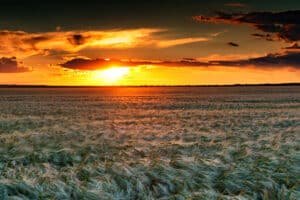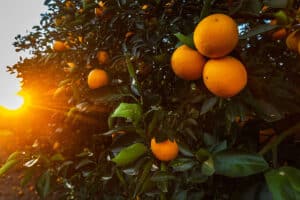Most of America’s land today is still rural. And 200 years ago, most Americans were family farmers on family farmland—but no more.
The number of farms — generously defined as any outfit from which $1,000 or more of agricultural products were sold or would normally be sold — is down to fewer than 2.1 million, from about 6.8 million in 1935. The number of farm acres is declining as well, down to about 933 million acres in 2005 from 987 million in 1990.
The majority of the farms America has now are small; they might be called, “sort of funny farms.” About 40 percent (834,000) are classified as residential/lifestyle farms, and 14 percent (291,000) are retirement places. Another 20 percent are “limited-resource” operations with less than $100,000 in annual gross sales and total household income of less than $20,000.
Some parts of rural America — where land is marginal, climate severe and life tough — are being evacuated. Farm population and many towns throughout the upper Midwest and the 1930s Dust-Bowl are declining.
A recent book by Richard C. Longworth, Caught in the Middle: America’s Heartland in the Age of Globalism, describes a region of cities, towns and farms losing out. Farmland lacks farmers. Those who survive are hooked on subsidies and made into vassals of global corporations, according to Longworth.
Yet in some spots — like Valley County, Idaho; Teton County, Wyoming; Eagle County, Colorado; and dozens of communities along the Atlantic Coast and in the mountains of Vermont, New Hampshire, New York and Massachusetts — rural populations are stable, even growing. Income is rising along with property values Their country roads are dotted with new tricked-out SUVs, and more foie gras is being sold at the newly up-scaled general store than canned Vienna sausages.
So who is moving to rural America these days?
Two recent articles — one in the New York Times, the other in the Wall Street Journal — provide one answer.
Kirk Johnson discovered the “…rise of a new landed gentry in the West.., the super-wealthy elite [wading] ashore where it will.” Many of their beachheads border public lands. (Kirk Johnson, “As Logging Fades, Rich Carve Up Open Land in West,” New York Times, October 13, 2007.)
The Journal’s Conor Dougherty wrote on January 19, 2008: “…broad swaths of rural America — from New England to the Rocky Mountain West — are being gussied up…[by] affluent retirees and other high-income types…creating new demand for amenities like interior-design stores, spas and organic markets.”
The shift in the local population mix shows up in county income data collected by the Commerce Department. New migrant wealth appears as a large rise in per-capita income from investment dividends, interest and rent. Gains in wages and salaries are not driving the per-capita gain in these hot spots.
In the worst case, some towns have become so wealthy that everyone else –teachers, cops, blue-collar labor — can no longer afford to live there.
Dougherty called this internal migration, “rural gentrification.” He quoted Peter Nelson, associate professor of geography at Middlebury College, as saying, “‘What we’re seeing is a class colonization…a shift in the nature of the economy from a resource-extraction economy to an aesthetic-based economy.’”
I’ve seen four types of non-farm money moving back to the land.
Individuals — Ted Turner, Brad Kelley who sold Commonwealth Brands cigarettes, Jeff Bezos of Amazon.com and others — have bought huge ranches, amounting to hundreds of thousands of acres individually and millions collectively. These seem to stay in agriculture, though bison may replace cattle.
The new owners tend to be environmental protectionists. Such holdings are investments with lifestyle benefits.
The second pattern is that of gated-style hamlets in pretty spots that are physically, economically, sociologically and often psychologically separate from their host counties.
These villages can be largely self-sufficient and don’t strain local schools and public recreation. They increase the tax base, but they also tend to pull up surrounding property values. Their residents usually volunteer for and contribute to local good works.
They don’t mix in much with local politics, and local residents usually don’t have much interaction with the hamlets, except as service workers.
The third pattern involves middle-class people from urban areas buying second homes and retirement places in the country. They’re the ones buying the retirement and lifestyle farms, or small tracts on which they build. Their purchases boost property values and the reassessments that follow.
They participate actively in their local communities. Whether Republican or Democrat, they lean toward protecting the local environment and keeping things pretty much the same as when they first arrived. Stress between been-heres and come-heres often involve these newcomers.
The fourth pattern finds fixed-income retirees moving to small towns and the country to stretch their dollars. These folks tend to fit in to the degree that they spread out and not wad up.
Quality-of-life concerns drive each group to the countryside. Migrant wealth has no need to make a living either from the land or locally. While newcomers bring money and different ideas to a community, they’re not agents of a colonizing power. But they are agents of change.
Where the new migrants have taken over economically and culturally, they’ve severed their community from dependency on mining, logging and farming. Folks from the old economy either adapt or leave. The change is from a production economy to one based on servicing the new source of wage income.
Change brings both benefits and costs, which are never fairly and evenly distributed.
Where migrant wealth stays segregated in pretty ghettos, local residents benefit least. As rural sociologist Cynthia Duncan of the University of New Hampshire suggests, efforts that succeed in breaking the “norms of separation” in a rural community encourage wide-based growth and civic improvement.
A rising tide in the countryside will undoubtedly lift all boats, that is, all boats that float. Those that are taking on water when the tide comes in, sink.
This content may not be used or reproduced in any manner whatsoever, in part or in whole, without written permission of LANDTHINK. Use of this content without permission is a violation of federal copyright law. The articles, posts, comments, opinions and information provided by LANDTHINK are for informational and research purposes only and DOES NOT substitute or coincide with the advice of an attorney, accountant, real estate broker or any other licensed real estate professional. LANDTHINK strongly advises visitors and readers to seek their own professional guidance and advice related to buying, investing in or selling real estate.









Add Comment